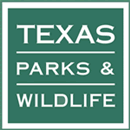Texas Parks and Wildlife Department

The Texas Parks & Wildlife Department (TPWD) is a Texas state agency that oversees and protects wildlife and their habitats. In addition, the agency is responsible for managing the state's parks and historical areas. Its mission is to manage and conserve the natural and cultural resources of Texas and to provide hunting, fishing, and outdoor recreation opportunities for the use and enjoyment of present and future generations.[1]
The agency maintains its headquarters at 4200 Smith School Road in Austin.[2][3][4]
History
In 1895, the Texas Legislature created the Fish and Oyster Commission to regulate fishing. The legislature added the Game Department to the commission in 1907. The Legislature created the State Parks Board as a separate entity in 1923. In 1963, the Texas Parks and Wildlife Department was formed through merger of the State Parks Board and the Game and Fish Commission.[5]
In 1983, the Texas legislature passed the Wildlife Conservation Act, giving the department the authority for managing fish and wildlife resources in all Texas counties. The department operates 95 state parks and historic sites, 51 wildlife management areas, eight fish hatcheries, and numerous field offices statewide. On January 1, 2008, TPWD transferred management of several historic sites to the Texas Historical Commission.
Employees
The agency employs more than 3,500 permanent employees, and 300 interns every summer, from every field of study. Intern programs vary but are typically 12 weeks long and go from May until August.[6]
Game wardens undergo a 30-week course at TPWD's Texas Game Warden Training Center in rural Hamilton County, Texas.[7]
Game Warden Ranks
| Title | Insignia |
|---|---|
| N/A | |
Organization
The department is made up of 11 divisions:[8]
- Administrative Resources
- Coastal Fisheries
- Communications
- Human Resources
- Information Technology
- Infrastructure
- Inland Fisheries
- Law Enforcement - Game wardens and deputy game wardens primarily enforce the provisions of the TPW Code but are fully empowered peace officers with statewide jurisdiction and may make arrests for any offense.[9]
- Legal
- State Parks
- Wildlife
Magazine
TPWD publishes Texas Parks and Wildlife, a monthly magazine available both in print and online editions. The magazine features articles and full-color photos on topics such as birding, boating, camping, fishing, hunting, state parks, travel, wildlife, and environmental issues. Texas Parks and Wildlife has been in publication since 1942.[10]
Television Series
Texas Parks & Wildlife is a weekly, half-hour television series aired on Texas PBS stations, as well as on a number of other PBS stations around the country. Viewers can stream episodes on the PBS website and on the TPWD YouTube channel.
Originally titled Made in Texas, the series began production in 1985 as a magazine style show, with three or four different segments each week. For several years, the show focused on one topic each week, documentary style. In 1991, the name of the series changed to Texas Parks & Wildlife and reverted to its original magazine format.[11]
Reality Series: Lone Star Law
Beginning in June 2016 TPWD Game Wardens were featured in a new reality television series on Animal Planet, Lone Star Law.
Radio Series
Passport to Texas is a daily series broadcast on radio stations throughout Texas, as well as available as downloadable podcasts. The series includes 90 second radio spots on topics, including wildlife, state parks, and outdoor activities.[12]
Texas Parks and Wildlife Foundation
Founded in 1991, the Texas Parks and Wildlife Foundation is the nonprofit funding partner of TPWD. Overseen by a board of trustees and administered by full- and part-time staff members, the foundation has raised over $100 million since its inception to ensure all Texans can enjoy, explore, and be inspired by the wild things and wild places in Texas.[13]
Deceased officers
Since the establishment of the Texas Parks and Wildlife Department Law Enforcement Division, 18 officers have died in the line of duty, including officers from the Texas Game and Fish Commission and the Texas Game, Fish, and Oyster Commission, which merged into the Texas Parks and Wildlife Department.[14][15][16]
See also
References
- ↑ http://tpwd.texas.gov/about/mission-philosophy Retrieved on March 5, 2016.
- ↑ "Directions to TPWD Headquarters." Texas Parks & Wildlife Department. Accessed August 28, 2008.
- ↑ "Directions to TPWD Headquarters." Texas Parks & Wildlife Department. Retrieved on July 6, 2010.
- ↑ "City of Austin Development Map Viewer." City of Austin. Accessed August 28, 2008.
- ↑ http://tpwd.texas.gov/about/history Accessed on March 5, 2016.
- ↑ "TPWD Activities and History". Texas Parks and Wildlife Department. 2006-04-26. Retrieved 2006-09-11.
- ↑ http://tpwd.texas.gov/warden/recruiting-careers/career
- ↑ http://tpwd.texas.gov/about/history
- ↑ Texas Parks and Wildlife Code, Section 11.019.
- ↑ http://www.tpwmagazine.com/about/Retrieved on March 5, 2016.
- ↑ http://tpwd.texas.gov/newsmedia/tv/tvabout.phtml Retrieved on March 5, 2016.
- ↑ http://passporttotexas.org/about/ Retrieved on March 5, 2016.
- ↑ http://www.tpwf.org/who-we-are/about-us/ Retrieved on March 5, 2016.
- ↑ Officer Down Memorial Page, TPWD Law Enforcement Division
- ↑ Officer Down Memorial Page, Texas Game and Fish Commission
- ↑ Officer Down Memorial Page, Texas Game, Fish, and Oyster Commission
External links
- Texas Parks & Wildlife Department website
- Texas Parks & Wildlife Foundation website
- Texas Parks & Wildlife magazine
- Passport to Texas website
